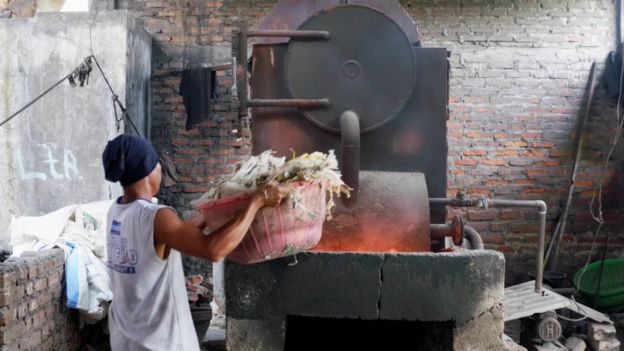jueves, 28 de noviembre de 2019
Unusual jobs
Watch this video about unusual jobs and then answer the questions in the document you'll find at the bottom of the post. If you went to the last class, remember that you already have a copy.
Questions video unsusual jobs
Questions video unsusual jobs
miércoles, 20 de noviembre de 2019
You're not alone: how to survive your horrible boss
Working under a bully can do real damage to your mental health. But there are ways to protect yourself
In hindsight, Zoe regrets not heeding the red flags she noticed when interviewing for the office job she held for a year. “The CEO joked around a little bit inappropriately,” she recalls, “Also, I heard him yelling in his office when I was waiting for my interview to begin.”
Soon after she was hired, Zoe (whose name has been changed to protect her professionally) realized her boss hadn’t just been having a bad day; he was a bully and a big-time yeller.
“I think he thought that respect could be gained by being the loudest one in the room, and he yelled because he wanted to assert his dominance,” she says. Not that it worked. “It made it seem like he didn’t have control and didn’t actually know what was going on,” she adds.
There are, according to Dr Gary Namie, director of the Workplace Bullying Institute, 25 common habits that can qualify a boss as a bully. Of this list, most bad bosses mix several nasty traits to create their own particular flavor of intolerability. Zoe’s boss, for example, embodied a spicy blend of “exhibiting presumably uncontrollable mood swings”, “making verbal put-downs” and “yelling, screaming and throwing tantrums”.
Zoe hadn’t experienced anything like her boss’s temper before. She remained silent as he ranted, often about things that had practically nothing to do with her work, like how annoyed he was that the coffee machine was malfunctioning, or that her whole generation was lazy and selfish. When he finished, she returned to her desk and struggled to regain her calm and focus for the rest of the day.
It wasn’t long before the stress Zoe felt from being yelled at began to affect her personal life.
“It taxed my relationship with my boyfriend horribly,” she says. “He spent a year listening to me cry and scream and get out all of my negative emotions that should have been aimed at my boss, and unfortunately it burnt him out, and it burnt out the whole relationship.”
Zoe quickly realized she had more to lose. “I had lost energy for almost all the things that I loved doing,” she says. “I realized I was losing who I was because I was so unhappy.”
She soon quit.
For those who have never had an abusive boss, Zoe’s story may sound shocking – but situations like hers are not uncommon: half of both the US and UK workforces report having left a job because of a boss who yelled at or otherwise tormented employees.
A 2017 study on abusive supervision found that people who have worked with a bullying boss report being more withdrawn and depressed, and that targets of abusive supervision report symptoms that bear “striking similarities to those diagnosed with post-traumatic stress disorder”.
Research has long supported a link between workplace abuse and negative consequences for employees – if your boss is antagonistic, you’re more likely to have anxiety and stress headaches, and lose sleep and your ability to concentrate. A new study from the International Journal of Environmental Research and public Health even found people coping with workplace abuse had a heightened risk of developing cardiovascular disease.
In some cases, workplace abuse can be contagious within an organization. For instance, in 2013, the Journal of Applied Psychology found American soldiers in Iraq were more likely to admit to hitting and kicking innocent civilians and were less likely to report misdeeds by others when their supervisors were also cruel to them.
According to the author and Ask a Manager blogger Alison Green, young or new employees can be especially impressionable: “If you have someone modeling how to manage while yelling, there is a high risk that [new managers] are going to pick that up as well,” she says. “People get their cues of what is and isn’t acceptable from their managers and treating someone badly simply because you have power over them is pretty abusive.”
It’s easy to understand how victims of a bully boss can incur personal costs and lose their confidence and productivity. Yet new research from Villanova University reveals that it’s not just workers who suffer when their boss is abusive – it may come as a relief to learn that bad managers themselves face consequences for being insufferable jerks.
“What we found is that the abusive boss is significantly hurt by their own behaviors,” says the lead researcher, Dr Manuela Priesemuth. “They actually lose their social worth, which is basically feeling valued and appreciated by other people. And because they miss this crucial component of self-worth, they’re also going to perform worse at their work.” Basically, if you treat people badly they’re not going to like you, and for social creatures like humans, being disliked is hurtful and disadvantageous.
Is that good news? Well … kind of. Priesemuth found “many managers realize the social costs of their behavior and stop – unless they have psychopathic tendencies”.
Psychopaths, Priesemuth explains, “don’t really care about social worth because they don’t really care about other people.” If your abusive boss belongs to the 15% of bad bosses who Priesemuth determined are psychopaths, that’s “very bad”, she says.
So let’s consider the worst-case scenario: what do you do if you are working with someone you suspect is pathologically callous, and, for whatever reason, you are unable or unwilling to simply quit?
“I would start by asking – am I safe having a gentle, backstage conversation with this person about their behavior?” says Robert Sutton, Stanford professor and author of 2017’s The Asshole Survival Guide: How to Deal with People who Treat You Like Dirt. “And if you don’t feel safe, then who in your network can you recruit to confront this person with you?”
If confrontation is not going to fly, Sutton suggests what he calls “mind tricks to save your soul”: essentially cognitive behavioral therapy tactics involving mentally reframing a threat to reduce its impact.
One such trick is just to see the existential absurdity of your torment in the context of the fleeting nature of time. “When something’s unpleasant, you remind yourself that this is just temporary, and that ‘when I look back at this, a year or two from now, it’ll just be nothing’,” says Sutton.
Yet if the idea of needing to dissociate from your dreary plight as a beleaguered office grub just to survive seems a little too soul-destroying to be a viable solution, studies suggest you can, in fact, fight fire with fire. Research from 2014 found that employees with hostile bosses are better off when they respond with passive aggression.
The study, conducted by Professor Bennett Tepper of Ohio State University, found that employees who responded passive-aggressively to their abhorrent bosses by ignoring them, feigning ignorance of the cause of their rage, or just giving a half-hearted effort were “less likely to see themselves as victims”.
When employees retaliate against bad bosses, they suffered less psychological distress and job dissatisfaction. What’s more, these employees didn’t feel like their reciprocal hostility negatively affected their careers – rather, Tepper posits they may in fact enjoy increased admiration from their colleagues, thereby becoming more committed to their workplace.
Handling an abusive boss, then, is not unlike dealing with a schoolyard bully: if you can’t walk away or remain unbothered by their antics, it may be best to fight back.
The Guardian, Adrienne Matei, 20th Nov 2019
jueves, 14 de noviembre de 2019
Western plastics 'poisoning Indonesian food chain'
The burning of plastic waste in Indonesia, much of which has been sent there by the West, is poisoning the food chain, the BBC has learned.
Environmental group IPEN found, in one East Java village, toxic dioxins in chicken eggs 70 times the level allowed by European safety standards.
Long-term exposure to the chemicals is linked to cancer, damage to the immune system and developmental issues.
Indonesia's government says it is sending the waste back to countries.
The BBC's Victoria Derbyshire programme also spoke to people with respiratory issues caused by the fumes from the burning of plastics, and filmed the open burning of plastics supposedly sent to Indonesia to be recycled.

At one tofu factory, plastic is burnt as fuel.
Researchers from IPEN (the International Pollutants Elimination Network) collected free-range chicken eggs at two sites near Surabaya, in East Java.
Testing eggs, the researchers said, was the easiest way to check whether the chemicals known as persistent organic pollutants (POPs) such as dioxins had made it into the food chain.
The most serious reading was taken near a group of tofu factories that burn plastics for fuel, in the village of Tropodo.
The tests found eating one egg would exceed the European Food Safety Authority (EFSA) tolerable daily intake for chlorinated dioxins 70 times over.
Researchers said this was the second-highest level of dioxins in eggs ever measured in Asia - only behind an area of Vietnam contaminated by the chemical weapon Agent Orange.
The eggs also contained toxic flame-retardant chemicals, SCCPs and PBDEs, used in plastics.
One resident in Tropodo said it was known as the "city of smoke".
"We don't need to tell the doctor what our symptoms are... we just tell them that we are from Tropodo and they know right away."
Experts believe eating a few contaminated eggs would not impact health - but long-term exposure could lead to serious problems.
"The results of our research are some of the most shocking we have ever had. In Indonesia, we've never had these results before," explained Yuyun Ismawati, a leading Indonesian environmentalist behind the tests.
Dr Agus Haryono, from the Indonesian Institute of Sciences, said the country's government needed to implement "a proper infrastructure for testing and monitoring POPs [Persistent Organic Pollutants]" to combat the "uncontrolled cross-border plastic trade".

In the first six months of this year, the UK sent 18,000 tonnes of plastic and 55,000 tonnes of paper to Indonesia
The researchers focused on the area around a paper factory in East Java, where around 40% of its paper is imported. But the paper is arriving contaminated with low quality plastic.
The plastic is then sold to local villagers, many of whom rely on the plastic for their livelihoods.
One so-called "plastic farmer" in the village of Bangun, Supiyati, told the BBC she made a living by searching through plastic waste to sell the better-quality material to plastic factories.
Continue reading this interesting BBC News article clicking here: Indonesia -plastics
lunes, 11 de noviembre de 2019
Would you like to take a healthy break?
Enjoy your stay!

Pleurisy, fracture at elbow, scalded buttocks, horse bite – who knew that a list of ailments on a hospital’s patient register could be so gripping? The one I found in my holiday accommodation (newly renovated Winsford Cottage Hospital in Devon) told the stories of people from a dozen local parishes. Within its handwritten pages I read of first world war soldiers with trench fever, second world war evacuees with asthma, plus farmers, labourers, cooks and teachers who had contrived to injure themselves in all manner of ways – and scores upon scores of women giving birth. Encouragingly, the patients whose discharge date is followed by the remarks “Cured”, “Much benefited” or “Satisfactory” far outnumber those with the more solemn “Died”.
That would doubtless have pleased Maria Medley. She was the wealthy benefactor who built what is now the Winsford Centre at Halwill Junction, 10 miles from Okehampton in 1899-1900 as a memorial to her husband George, who had passed away the previous year. In doing so, she transformed the lives of locals who couldn’t afford to call a doctor and often died of curable illnesses as a result. Back then, this part of Devon was busy. Halwill Junction takes its name from a now-disappeared railway station where lines from Barnstaple, Padstow, Bude and Exeter converged until Dr Beeching axed the lot in the 1960s. Unusually for such a rural village, it’s still easily accessible by public transport – I took a bus from Exeter St David’s station, passing Dartmoor on the way.


Pleurisy, fracture at elbow, scalded buttocks, horse bite – who knew that a list of ailments on a hospital’s patient register could be so gripping? The one I found in my holiday accommodation (newly renovated Winsford Cottage Hospital in Devon) told the stories of people from a dozen local parishes. Within its handwritten pages I read of first world war soldiers with trench fever, second world war evacuees with asthma, plus farmers, labourers, cooks and teachers who had contrived to injure themselves in all manner of ways – and scores upon scores of women giving birth. Encouragingly, the patients whose discharge date is followed by the remarks “Cured”, “Much benefited” or “Satisfactory” far outnumber those with the more solemn “Died”.
That would doubtless have pleased Maria Medley. She was the wealthy benefactor who built what is now the Winsford Centre at Halwill Junction, 10 miles from Okehampton in 1899-1900 as a memorial to her husband George, who had passed away the previous year. In doing so, she transformed the lives of locals who couldn’t afford to call a doctor and often died of curable illnesses as a result. Back then, this part of Devon was busy. Halwill Junction takes its name from a now-disappeared railway station where lines from Barnstaple, Padstow, Bude and Exeter converged until Dr Beeching axed the lot in the 1960s. Unusually for such a rural village, it’s still easily accessible by public transport – I took a bus from Exeter St David’s station, passing Dartmoor on the way.
Winsford’s designer was CFA Voysey, a friend of the Medleys and one of the most influential arts and crafts architects of his day. He almost exclusively designed grand houses, which explains why Winsford (with its striking triple gables and long band of mullioned windows) looks decidedly unlike a hospital. Barbara, the property’s housekeeper, pointed out to me that he’d even taken the trouble to make all the doors deliberately wide and low, “so they didn’t remind people of the shape of coffins”. It’s no wonder many of those who came to view the hospital when it opened in 1900 wrote in the visitors’ book that they wished they could live in it.
I found the interior oddly reminiscent of an early video game. Standing in the entrance hall I faced a long, wide corridor with myriad identical doors off it and no way of knowing what was behind them, until I pushed down on their latches and peered in. Along with four bedrooms, I discovered a tiny study, three bathrooms (two of which had baths, in one of which I later enjoyed gloriously languorous soaks), a flashily equipped kitchen, a delightfully formal dining room and a lounge with sofas so generously proportioned that I could almost have disappeared into them. Blissfully, there was neither a television nor wifi. In their place I found a library curated by one of the Landmark Trust’s librarians, a chronicle of the hospital written by historian Caroline Stanford, and that fascinating register of patients.

It was difficult to believe that the building – which closed in 1998 – had been in a state of advanced decay as recently as last year, when the Landmark Trust took it over. Using skilled local tradesmen and volunteers, it took Winsford back to how it would have looked in 1914, when its seven beds began to be filled by wounded and ailing soldiers. Cement was removed to reveal the sand-coloured mosaic floor; the Cornish Delabole slate roof was overhauled; the original fireplaces (decorated with Voysey’s celebrated elongated hearts) were carefully preserved; and the white-and-dark-green colour scheme was reinstated. In all, the trust spent £1.5m on restoration, creating an extensive holiday property while maintaining the east wing for community use (here one room has been mocked up as an early-20th-century ward). (...)
Read the whole article clicking here:
lunes, 4 de noviembre de 2019
Suscribirse a:
Entradas (Atom)

